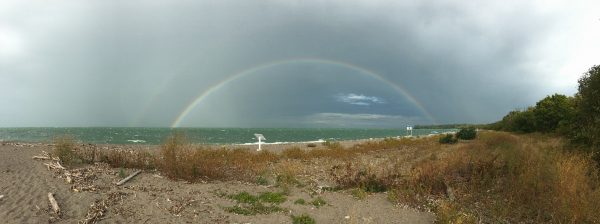Double rainbow at Fish Point. Photo by Patrick Kramer
The second fortnight of October began with a morning of north winds, during which PIBO banded 121 birds. Most of them were the ubiquitous Ruby-crowned Kinglets and Golden-crowned Kinglets, but Hermit Thrushes and Myrtle Warblers also continued to be common. By the following day the wind had shifted to the southwest and the morning was quiet: only fifteen birds of five species were banded. October 18th was distinguished by strong south winds and even fewer species of birds, though large flocks of American Robins began to appear on census and in the netting area. Subsequent days were also quiet, with a few small groups of kinglets captured here and there each morning. Large flocks of blackbird species, including Red-winged Blackbirds, European Starlings, and Common Grackles, were seen frequently flying high overhead. Woodpecker species were also a constant in the netting area, with Downy Woodpeckers, Red-bellied Woodpeckers, Yellow-shafted Flickers, and Yellow-bellied Sapsuckers all being seen on most days.
Sharp-shinned Hawks were active in the netting area on October 19th. A plucked kinglet carcass was discovered in one of the mist nets, where it had probably been dropped by a hawk who subsequently bounced out of the net. A second Sharp-shinned Hawk was not so lucky – it hit the mist net while carrying a Hermit Thrush, could not get out, and was banded at the station. The Hermit Thrush it had captured was still alive when it was found and was released unbanded (it had already experienced enough excitement for one morning!). Later, another Sharp-shinned Hawk flew past the banding station very low, and appeared to be carrying its latest meal with it. Overall, the hawks appeared to be having more luck capturing birds than PIBO – only three songbirds were banded that morning!
As the end of October generally marks the end of songbird migration, it did not come as a surprise that fewer species of birds were being observed. The daily total of birds seen on census and in the netting area was generally around 20 to 35 species, a decrease from the forty to fifty species seen in the first half of the month. Nevertheless, the season still held a few surprises. The morning of October 26th began quietly, but by 10:30 a.m. bird activity had reached a crescendo at the banding station. Golden-crowned Kinglets, Ruby-crowned Kinglets and White-throated Sparrows were captured in abundance, with 161 birds of 18 species banded in total. The total number of species seen that morning reached 64 (as opposed to 34 the day before). It was also the day when we observed the highest diversity of sparrow species. As seed-eaters, sparrows are some of the last birds to migrate, and October 26th was the first day when Field Sparrows and Fox Sparrows were seen by PIBO this fall. Nine sparrow species were observed in total, including Lincoln’s Sparrow, Swamp Sparrow, and Slate-coloured Junco. Eleven Song Sparrows were banded, which is one of the highest numbers of this species that PIBO has ever banded in a single day. A Marsh Wren was also captured, and was the first one seen or heard this fall.
October 26th was also the last day in October on which monarch butterflies were seen on census. The persistent bad weather and hurricanes farther south appear to have retarded their migration, and significant numbers of them were seen throughout the month. They were especially numerous on October 19th and 20th, when 52 and 40 monarchs were counted respectively! It will be interesting to see if any are sighted next month, as only one monarch was counted by PIBO in November 2016.
The temperature dropped noticeably on October 28th and from then on high winds, grey skies, and the occasional rain squall made it feel considerably more like fall. 78 birds were banded on October 29th, 56 of which were Golden-crowned Kinglets. Three already-banded kinglets were recaptured, all of whom had been banded on October 26th and had evidently decided to stay on the island for a few days. The last few days in October were uneventful, and the nets were frequently closed early due to rain and strong winds. No birds at all were captured on October 31st – a quiet end to the month.
PIBO held two public owling nights in October, where members of the public were invited to the PIBO field cottage for an evening of owl banding and light refreshments. We were pleased to host a crowd of almost thirty people on October 21st, when in spite of the unseasonably warm weather we succeeded in capturing a young Eastern Screech Owl. The following public owling night on October 28th was less well-attended, which was just as well, since no owls were captured at all, though the weather seemed favourable. PIBO’s field supervisor Sumiko Onishi did open the nets on two evenings in between the public owling nights, and banded two Northern Saw-whet Owls.
PIBO’s third public owling night will take place this Saturday, November 4th, from 7:30 p.m. to 10 p.m., at the PIBO field cottage (585 South Shore Road). We thank you for your support, and hope to see you there!

